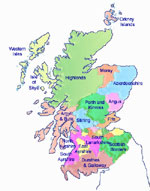| Invergarry is a village at the foot of Glengarry, on the
main Fort William - Inverness road through the Great Glen. Loch Oich,
Loch Garry and the Glengarry Forest are among the natural attractions
of the area, and the ruined 17th century Invergarry Castle is on the shore
of Loch Oich. |
|
|
Welcome to Invergarry Scotland
 Invergarry
lies a couple of hundred yards to the west of Glengarry Castle. Its focus
is the junction between the A82 as it crosses the River Garry over a high
concrete bridge built in the 1930s, and the A87 as it heads west along
the north side of Glen Garry en route to Kyle of Lochalsh. A little to
the south is the new Community Hall, which since 2006 has been the home
of the Information Centre. Invergarry
lies a couple of hundred yards to the west of Glengarry Castle. Its focus
is the junction between the A82 as it crosses the River Garry over a high
concrete bridge built in the 1930s, and the A87 as it heads west along
the north side of Glen Garry en route to Kyle of Lochalsh. A little to
the south is the new Community Hall, which since 2006 has been the home
of the Information Centre.
Most of the village is strung out along the A87 to the west of the junction.
The most striking of the buildings here is the Invergarry Hotel.
Glengarry Parish Church is placed above the road and a little back from
it. The core of this was built in 1864, though the tower and other extensions
came along in 1896. When viewed as part of a run of buildings including
some very attractive cottages with superbly cared-for gardens, the church
adds much to an already very attractive village. Read
more..
Accommodation in and around Invergarry
Price Guide - per person based on sharing room:  under $40 -
under $40 -  $41
- 70 - $41
- 70 -  more than
$70 more than
$70
Some History about Invergarry Castle
Invergarry Castle had an eventful 150 years. It first saw action
when Cromwell's troops under General Monck burned it down in 1654. Repaired,
it was held for James VII/II from 1688 until its surrender to the forces
of William and Mary in 1692 (see our Historical Timeline). It was then
held by the Jacobites during the 1715 uprising, but taken for the government
in 1716. And during the 1745 uprising it was again held by Jacobites and
visited twice by Bonnie Prince Charlie. In the aftermath of Culloden it
was sacked and partially blown up by troops under "Butcher Cumberland"
as part of his systematic su For several centuries the story of Invergarry
was the story of the MacDonnell family. They were the lairds here when,
after raids by the Mackenzies in 1602, they decided to fortify the Rock
of the Raven, a rocky outcrop on the west bank of Loch Oich. The result
was an imposing five storey L-plan tower house, Invergarry Castle. ppression
of the Highlands.
In 1754, Alestair Ruadh MacDonnell became laird and the confiscated family
estates were returned to him, probably in return for services he had rendered
as a spy in the Jacobite camp on the continent. He became the first of
a series of MacDonnell lairds who worked hard to exploit their estates
to their maximum.
They stripped much of the area of its forests, passing the wood through
a sawmill they built in Invergarry. The last of the woodland was shipped
out as logs via the newly built Caledonian Canal in the decade up to 1830.
The area has regained much of its previous woodland since.
During the 1780s the MacDonnells also cleared their land of much of its
population, on the basis that there was more money to be made by grazing
sheep on the land than by allowing it to be used by the existing tenants
for their cattle.
The MacDonnells lost the estate at about the time the woodland ran out.
Between 1866 and 1869 the new lairds of the estate, the Ellice family,
built the imposing Invergarry House a little to the north of the ruins
of Invergarry Castle.
The last of the Ellices to live in Invergarry House as laird of Glengarry
and Glenquoich was Edward Ellice. Ellice, who could speak Gaelic speaker,
aimed to encourage the people of the glens to maintain local traditions:
at least, presumably, those local traditions which had not been wholly
obliterated during the MacDonnells' tenure.
Edward Ellice died in 1934 and in 1960 Invergarry House was reborn as
the Glengarry Castle Hotel. It enjoys an enviable position overlooking
Loch Oich, with the added attraction of the ruins of Invergarry Castle
in the grounds.
|
![]() Email enquiries & reservations: bookscotland@madbookings.com
Email enquiries & reservations: bookscotland@madbookings.com
 Invergarry
lies a couple of hundred yards to the west of Glengarry Castle. Its focus
is the junction between the A82 as it crosses the River Garry over a high
concrete bridge built in the 1930s, and the A87 as it heads west along
the north side of Glen Garry en route to Kyle of Lochalsh. A little to
the south is the new Community Hall, which since 2006 has been the home
of the Information Centre.
Invergarry
lies a couple of hundred yards to the west of Glengarry Castle. Its focus
is the junction between the A82 as it crosses the River Garry over a high
concrete bridge built in the 1930s, and the A87 as it heads west along
the north side of Glen Garry en route to Kyle of Lochalsh. A little to
the south is the new Community Hall, which since 2006 has been the home
of the Information Centre. 















